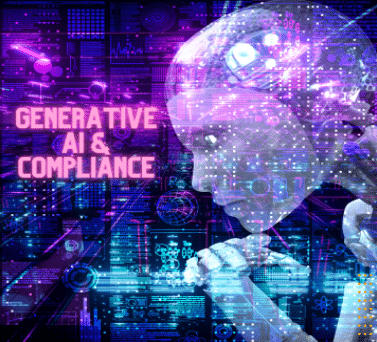- 8 minute read
Artificial intelligence (AI) has revolutionized many industries, with Generative AI emerging as a transformative force in the vast world of content creation. From streamlining operations to creating personalized experiences, its applications touch many business sectors. Deploying generative AI will be a dual-edged sword, presenting exciting opportunities and significant risks. This in-depth article aims to provide readers with a deeper insight into the dangers and great opportunities AI offers to two different billion-dollar industries: Banking and the Adult Entertainment business.
Generative AI in the Banking Sector:
Artificial Intelligence (AI) has proven to be a game-changer in the banking industry, streamlining processes, enhancing customer experiences, and revolutionizing decision-making. Among the different branches of AI, generative AI stands out for its ability to create new data, images, text, or even entire scenarios based on existing patterns. While generative AI offers tremendous opportunities for innovation and growth in banking, it also comes with significant risks that require careful consideration. This chapter will explore the dual nature of generative AI in the banking sector, highlighting its potential benefits and challenges.
Look at the Bright Side!
Personalized Customer Experiences
Generative AI enables banks to offer personalized services tailored to customers’ needs and preferences. By analyzing vast amounts of data, including transaction histories, spending patterns, and demographic information, banks can create hyper-personalized recommendations, such as customized financial plans, investment strategies, and product suggestions. This level of personalization enhances customer satisfaction, improves customer relationships, builds trust, and strengthens brand loyalty.

Enhanced Fraud Detection and Security
One of the most significant advantages of AI and Machine Learning in banking is its ability to detect fraudulent activities and enhance security measures. By analyzing patterns in transaction data, generative AI algorithms identify anomalies and suspicious behavior in real time, flagging potentially fraudulent transactions for further investigation. This proactive approach to fraud detection minimizes financial losses for banks and customers, strengthens cybersecurity posture, and mitigates data breaches and cyber-attack risks.
Process Automation and Efficiency
AI has the potential to automate repetitive tasks and streamline operational processes, leading to much greater efficiency and cost savings. Tasks such as data entry, document processing, and customer service can be automated using AI-powered chatbots and virtual assistants, freeing up human employees to focus on more complex and high-value activities. By reducing manual errors and increasing operational speed, generative AI enables banks to deliver faster and more reliable services to their customers, ultimately improving overall productivity and competitiveness.
Risk Management and Compliance
AI is crucial in risk management and regulatory compliance within the banking industry. AI algorithms quickly identify potential risks and compliance issues before they escalate by analyzing vast amounts of data from multiple sources, including financial markets, regulatory filings, and customer transactions. Transactions are monitored automatically, and changes in risk profiles are detected in real-time. This proactive approach allows banks to anticipate regulatory changes, assess the impact on their operations, and take appropriate measures to ensure compliance, thereby reducing the risk of costly penalties and reputational damage.
Data-driven Decision Making
With the help of AI, banks can make more informed and data-driven decisions across various aspects of their business operations, including lending, investment, and customer acquisition. By analyzing historical data and market trends, AI algorithms can identify patterns, correlations, and predictive insights that human analysts may overlook. This enables banks to optimize their strategies, minimize risks, and capitalize on emerging opportunities in a rapidly evolving financial landscape, ultimately driving business growth and profitability.
What dangers lurk in the shadows of Generative AI in Banking?
Data Privacy and Security Concerns
While AI significantly benefits fraud detection and security departments, it also raises concerns about data privacy and confidentiality. The collection and analysis of vast amounts of customer data increases the risk of data breaches, unauthorized access, and misuse of personal information. Banks must implement robust security measures, such as encryption, access controls, and data anonymization, to protect sensitive customer data from potential threats and vulnerabilities.

Algorithmic Bias and Discrimination
AI algorithms are trained on historical data, which may contain inherent biases and prejudices that can perpetuate discriminatory outcomes. For example, algorithms used for credit scoring or loan approvals may inadvertently discriminate against certain minorities based on factors such as race, gender, or socioeconomic status. Banks may also refuse merchants based on the type of business they run. Not all enterprises categorized as high-risk are high-risk, and business types classified as low-risk could hide risk (i.e., transaction laundering). To mitigate the risk of algorithmic bias, banks must ensure that AI systems are trained on diverse and representative datasets and regularly monitored for fairness and transparency.
Regulatory Compliance Challenges
Deploying generative AI in banking is subject to a complex regulatory landscape governed by stringent data protection, consumer privacy, and financial regulations. Banks must navigate a myriad of regulatory requirements, including GDPR, CCPA, PSD2, Basel III, and KYC/AML regulations, which impose strict requirements for data handling, consent management, and risk assessment. Ensuring compliance with these regulations requires significant investment in compliance infrastructure, resources, and expertise, which may pose challenges for smaller banks or fintech startups with limited resources.
Ethical and Social Implications
Generative AI raises ethical and social implications regarding the responsible use of AI technology and its impact on society. For example, using AI-powered chatbots and virtual assistants in customer service may raise concerns about job displacement and automation-induced unemployment. Additionally, using AI algorithms for credit scoring and loan approvals may raise questions about fairness, transparency, and accountability in decision-making processes. Banks must proactively address these ethical and social concerns through transparent communication, stakeholder engagement, and responsible AI governance practices.

Dependency on Technology
Banks increasingly rely on generative AI for critical business functions, so they become more vulnerable to technology-related risks and dependencies. Malfunctions, errors, or algorithmic failures in AI systems could have far-reaching consequences, disrupting banking operations, causing financial losses, and undermining customer trust. Banks must implement robust contingency plans, disaster recovery measures, and fail-safe mechanisms to mitigate the risks associated with technology dependencies and ensure business continuity in the event of AI system failures.
Latex and Velvet: Generative AI and Adult Entertainment
The Promise of Generative AI in Adult Entertainment
Notwithstanding the taboos associated with this type of business, the adult entertainment industry has always been at the forefront of technological innovation, pushing the boundaries of creativity and interactivity to captivate audiences worldwide. In recent years, generative artificial intelligence (AI) has emerged as a transformative force, offering this industry both exciting opportunities and challenging risks. Let’s have a look at the bright side.
Content Creation and Personalization
Generative AI empowers content creators in the adult entertainment industry to produce diverse and personalized experiences for their audience. From videos and images to text-based narratives, AI algorithms can generate content tailored to individual preferences and fantasies, transforming backgrounds and settings in artificial intelligence-generated virtual reality.

Targeted Marketing and Market Segmentation
Generative AI enables targeted advertising campaigns within the adult entertainment industry, leveraging user data and behavioral insights to deliver personalized content and recommendations. AI algorithms can identify niche markets and tailor advertising messages to specific audience segments by analyzing user preferences, browsing histories, and engagement patterns. This targeted approach maximizes marketing effectiveness, improves user engagement, and drives revenue for platform operators and advertisers.
Immersive Experiences with VR and AR
The combination of generative AI with virtual reality (VR) and augmented reality (AR) technologies allows users to immerse themselves in interactive adult experiences, interact with lifelike avatars, and customize their encounters according to their preferences. From virtual reality porn to augmented reality strip clubs, these technologies offer users a new dimension of sensory stimulation and exploration, blurring the lines between fantasy and reality.

Sexual Health Education and Diversity Representation
Generative AI can create educational content and simulations that promote healthy sexual practices, consent awareness, and diversity in representation. Educational content can encourage an open dialogue about sensitive topics such as sexual health, pleasure, and intimacy, fostering a more informed and inclusive society. By leveraging AI technology for sexual health education and awareness campaigns, the adult entertainment industry can contribute to positive social change and empower individuals to make informed choices about their sexual well-being.
Generative AI Risk: Exploitation, Privacy Concerns and Non-Compliance
Exploitation and Non-Consensual Use
The implementation of Generative AI-generated adult content raises concerns about exploitation, revenge porn, and non-consensual use of individuals’ likenesses. Malicious actors may use this technology to create fake imagery or manipulate images for nefarious purposes, leading to significant harm and trauma for the victims. As generative AI continues to advance, there is a pressing need for robust legal frameworks and technological safeguards to prevent the misuse of AI-generated content and protect individuals’ privacy and dignity. Another significant concern is how to safeguard minors and fight against content that violates age restrictions in a virtual AI-generated environment.
Impact on Relationships and Social Dynamics
Excessive consumption of AI-generated adult content could harm individuals’ relationships and social dynamics. By providing users with unlimited access to hyper-realistic sexual experiences, generative AI may contribute to addiction, isolation, and dissatisfaction with real-life relationships. Moreover, the normalization of unrealistic standards and fantasies portrayed in AI-generated content may distort users’ perceptions of intimacy, consent, and body image, leading to negative psychological and interpersonal consequences.
Privacy and Security Risks
Adult entertainment platforms’ collection and monetization of user data raises significant privacy concerns. User data, including browsing histories, preferences, and interactions, are often harvested and analyzed for targeted advertising and personalized content recommendations. Security breaches and data leaks could expose sensitive information, leading to embarrassment, harassment, or blackmail. To safeguard user privacy and security, adult entertainment platforms must implement robust data protection measures, such as encryption, anonymization, and user consent mechanisms, while complying with rules and regulations.
Normalization of Unrealistic Standards
AI-generated adult content often portrays idealized and unrealistic depictions of bodies, sexual encounters, and fantasies. This perpetuation of unrealistic standards may contribute to body image issues, low self-esteem, and unhealthy sexual attitudes among consumers, particularly young adults and adolescents. The emphasis on hyper-sexualized representations of women reinforces harmful stereotypes. To address these issues, content creators and platform operators must prioritize diversity, inclusivity, and ethical representation in their content production and distribution practices.
Regulatory and Legal Challenges

The legal and regulatory landscape surrounding AI-generated adult content is constantly evolving. Issues such as copyright infringement, intellectual property rights, and content moderation pose significant challenges for platform operators, content creators, and policymakers. The lack of clear guidelines and regulations governing the use of generative AI in adult business exposes all stakeholders involved to abuse, exploitation, and non-compliance risk. To address these challenges, policymakers must collaborate with industry stakeholders to develop comprehensive legal frameworks that protect individuals’ rights, ensure ethical content production and distribution practices, and promote a safe and inclusive online environment for all users.
Conclusion: Striking a Delicate Balance
Generative AI represents a paradigm shift in how businesses operate and interact with consumers in the banking and adult entertainment industries. While the opportunities for innovation and growth are undeniable, the risks and ethical considerations cannot be ignored. Industries that use AI must find a balance between harnessing the power of AI for positive transformation and mitigating its potential risks. This requires collaborative efforts from industry stakeholders, policymakers, and advocacy groups. By prioritizing privacy, fairness, and accountability, we can navigate the complex landscape of generative AI with confidence and integrity, ensuring its benefits and risks are maximized.
By addressing concerns related to data privacy, algorithmic bias, regulatory compliance, ethical implications, and technology dependencies, both industries can harness the transformative power of generative AI while mitigating its potential risks, ultimately driving sustainable growth and value creation in the digital age.
Want to learn more about your recurring payment processing options?
For questions and free advice about the implications of generative AI in your type of business, feel free to contact our Sales Consultants at: [email protected]
This article has been written by @SandeCopywriter on behalf of Segpay Europe.



